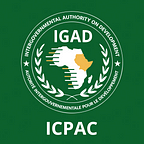Does El Nino Always Lead to Above Normal Rainfall? Examining the Short Rains in Eastern Africa during El Nino Years
By Dr Linda Ogallo, Herbert Misiani, Dr Masilin Gudoshava & Ismael Lutta with contributions from the IGAD Climate Change Technical Working Group
What is El Nino?
Global climate systems, notably the Indian Ocean Dipole (IOD) and El Niño Southern Oscillation (ENSO), exhibit a persistent and influential relationship with climate patterns in Eastern Africa (ICPAC, 2020). Given ENSO’s significant impact on temperature and precipitation worldwide, it holds relevance for predicting rainfall across a larger part of Eastern Africa. ENSO encompasses two contrasting phases: “El Niño” and “La Niña.” Previous research indicates that a positive El Niño signal typically corresponds with increased rainfall in the equatorial region of Eastern Africa, particularly when coupled with a positive IOD. This study scrutinizes recorded rainfall data spanning from October to December across diverse regions, focusing on years characterized by a positive El Niño signal. Additionally, the study compares these findings with concurrent IOD signals during the respective years under examination.
During the sixty-fifth Greater Horn of Africa Climate Outlook Forum (GHACOF 65), ICPAC’s October-December (OND) 2023 forecast highlighted an increased probability of experiencing above-normal rainfall in the equatorial region. The observed impacts of this season have already manifested in widespread flooding, leading to infrastructure destruction and loss of lives and livelihoods. The heightened rainfall is attributed to the positive phases of both ENSO and the IOD.
Historical El Nino Events and the corresponding IOD State
The extreme rainfall in Eastern Africa in 1997 attracted significant media attention, as the region witnessed unprecedented rainfall leading to widespread flooding and substantial loss of lives and property. Since then, the term “El Niño” has become synonymous with the impacts observed during the 1997 event. This article delves into historical El Niño events, examines the status of the IOD during those periods, and compares the corresponding rainfall during the OND rainfall season to the seasonal long-term average.
The El Nino years were all characterized by a positive IOD phase, with three years 1997, 2015, and 2023 having strong IOD signals during the OND season as seen in (Table 1). This ranking should ideally correlate with the observed data; however, this is not the case. 2002 and 2009 were wetter than 2015 in Garissa, despite having a weaker IOD and El Nino signal as shown in Figure 3. In Kampala, enhanced rainfall is observed in the three years with the strong IOD signals as shown in Figures 2 & 3. In 1987, despite a positive El Niño signal, all three rainfall stations with data recorded normal rainfall. The percentage deviation from the long-term average in both sites in Kenya during the El Nino years was generally exceptional with Garissa exhibiting over 20 times the average rainfall in 1997 as seen in Figure 3.
In October, strong positive El Niño and IOD signals were observed only in 1997 and 2023; however, 1997 was the only year that recorded exceptional rainfall. In 2023, three out of four stations recorded near normal conditions. The El Niño signal in 1982 was strong while the IOD signal was weak; however, Garissa station recorded five times the normal rainfall for October while the Dagoretti station received double its average amount. The rainfall amounts in both stations were similar to those observed in 1997. Despite having a positive El Niño signal in 1987, the sites in Kenya and Uganda recorded below-normal rainfall as shown in Figure 4.
In November, the El Nino and IOD signals were strong in 1997 and 2023. Exceptional rainfall was observed in both years with 2023 recording significantly more rainfall compared to 1997 in Garissa despite having a weaker IOD and El Nino signal as shown in Figure 5. Moreover, Figure 6 illustrates that a large part of the region received well above normal rainfall for the OND season.
When the month of December is considered, 2023 stood out as the only year with a strong El Niño and IOD signal. However, 1997 recorded the highest amount of rainfall received across all sites, despite having a weaker positive IOD signal. The argument could be made that the stronger El Nino signal observed in 1997 contributed to the more significant increase in rainfall than was observed in 2023 as shown in Figure 7. The observed rainfall pattern in 1987 remained puzzling, as all three stations with data showed below-normal rainfall despite a positive El Niño signal.
Conclusion
The study reveals a nuanced relationship between the El Niño signal and rainfall patterns across different regions of Eastern Africa. Contrary to common perceptions, the relationship between rainfall drivers and rainfall patterns in the region is complex and non-linear. Several key insights emerged from the analysis:
1. El Niño, often associated with heavy rainfall, does not consistently result in enhanced precipitation. While typically, increased rainfall occurs when El Niño coincides with a positive IOD signal, this correlation is not universally observed in the analyzed data.
2. Traditional analysis of rainfall on a seasonal basis may overlook important nuances. Monthly comparisons reveal variations in rainfall intensity and distribution, providing insights into impacts that might be missed when focusing solely on seasonal totals. Understanding climate extremes[HM1] [LO2] necessitates a shift towards examining the intensity and distribution of rainfall on a monthly basis and subsequently, on a daily basis. This approach is essential because some regions may experience their expected seasonal rainfall within a short timeframe, thereby amplifying the risks of disasters.
3. The use of observed data in this analysis underscores the need for investments in climate observation networks in the region and additional research to gain a more profound understanding of other drivers influencing rainfall in the Eastern Africa Region and the role of climate change.
